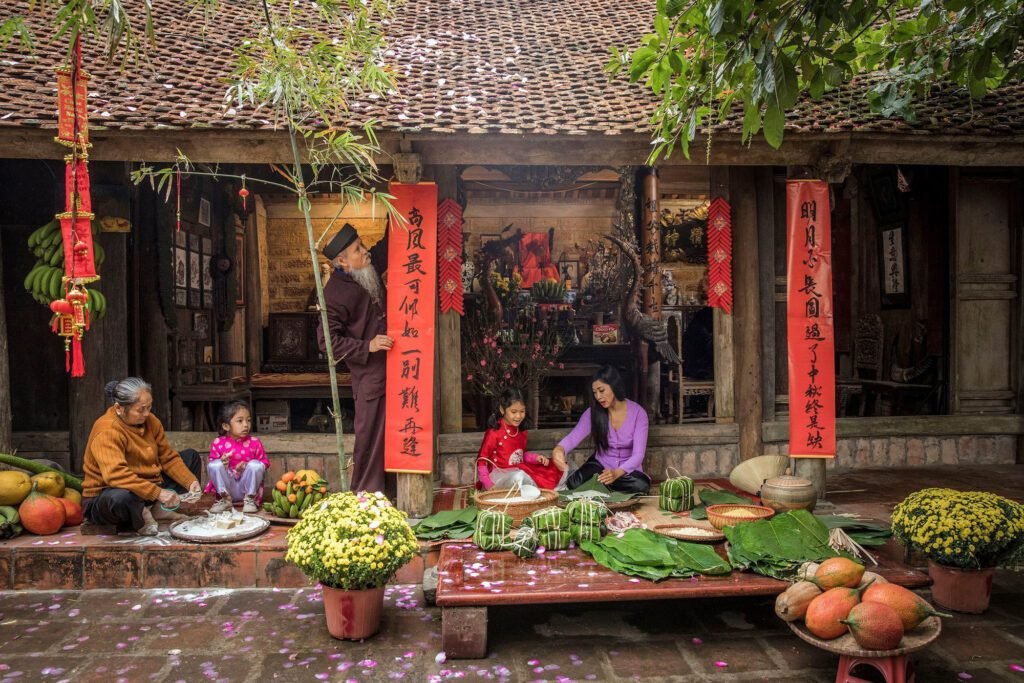Vietnamese Dining Etiquette & Table Manners: A Guide for Visitors
Vietnamese dining isn’t just about food—it’s an immersive cultural experience that embodies respect, family values, and traditions. For visitors, understanding Vietnamese dining etiquette can enhance your experience, foster better connections with locals, and ensure you don’t accidentally offend anyone. Here’s a complete guide to help you navigate Vietnamese table manners with confidence.
1. Pre-Dining Customs
Invitations and Hosting
Dining in Vietnam often begins with an invitation, which reflects a gesture of friendship or goodwill. If you’re invited to someone’s home or a restaurant, accept it graciously. Being invited signifies a willingness to share not only food but also a part of their culture with you.
Bringing a Gift
When dining at someone’s home, it’s customary to bring a small gift as a token of appreciation. In line with Vietnamese dining etiquette, common gifts include fresh fruit, sweets, or a bottle of wine. Avoid overly extravagant items, as this might make the host uncomfortable. If you’re unsure, a simple gesture, like neatly wrapping your gift, shows thoughtfulness.


Timeliness is Key
Arriving on time is not only polite but expected. While a slight delay of 5–10 minutes might be acceptable, consistently arriving late can appear disrespectful. Vietnamese hosts often put great effort into preparing meals, so punctuality acknowledges their hard work.
🇻🇳 Experience the vibrant atmosphere of Vietnamese festivals!
2. Table Arrangements and Seating
Respect for Hierarchy
In Vietnam, seating arrangements at the table often reflect societal hierarchies. In accordance with Vietnamese dining etiquette, elders or honored guests are seated first, typically in the most prominent positions. Therefore, it’s crucial to follow the host’s lead to find your seat; sitting down before elders or without instruction may seem impolite.
Traditional Table Setup
Vietnamese dining tables are usually communal, with all dishes placed in the center for sharing. Bowls of rice are served individually, while dishes like meat, fish, vegetables, and soups are shared among everyone. This setup emphasizes unity and community.


Explore: Unveiling Vietnamese Culture: Traditions, Etiquette & Festivals for Travelers
Handling Chopsticks Properly
Chopsticks are a staple in Vietnamese dining, and their usage comes with unspoken rules. In fact, understanding the nuances of Vietnamese dining etiquette, especially when it comes to chopsticks, is key to showing respect to your hosts and fellow diners.

🇻🇳 Gain a deeper understanding of Vietnamese family values and traditions.
3. Ordering and Serving Food
Family-Style Sharing
Meals in Vietnam are a communal affair. Dishes are ordered to share, and guests take what they need from the center of the table. It’s polite to serve others, especially elders, before serving yourself. This practice reinforces the value of respect in cultural etiquette in Vietnam.
Serving Elders First
In keeping with Vietnamese dining etiquette and the hierarchical traditions, elders are served first. Younger diners are expected to ensure that elders have received their portions before eating themselves. Consequently, this practice is a way of showing gratitude and reverence.
Portioning Shared Dishes
When taking food from shared dishes, use the communal serving spoon if provided. Avoid digging through the dish or taking the best pieces for yourself—it’s considered selfish.
🇻🇳 Uncover the historical and cultural significance of Vietnamese Temples!
4. Eating Practices
Mastering Chopstick Etiquette
Using chopsticks properly is essential in Vietnamese dining etiquette. Hold them near the ends, not the middle or base, and avoid using them to point at others or gesture. Furthermore, while chopsticks are commonly used for most dishes, spoons are typically provided for soups.


Embracing Slurping
In Vietnam, slurping isn’t frowned upon; instead, it’s often a sign that you’re enjoying the meal. In fact, according to Vietnamese table manners, whether you’re savoring a bowl of pho or sipping a broth, don’t hesitate to express your delight audibly.
Sticky Rice Customs
Sticky rice, or “xoi,” is a popular dish with its own etiquette. When eating sticky rice, use chopsticks to pick up small portions. Avoid scattering grains, as this can be seen as careless or disrespectful.


📸 Immerse yourself in Vietnam’s captivating culture. From ancient temples to vibrant festivals, there’s something for everyone. | Contact us via WhatsApp or follow Sun Getaways Travel Fanpage for personalized trip planning. Or follow these posts to explore the cultural wonders of Vietnam:
5. Social Interaction at the Table
Polite Conversations
Dining in Vietnam isn’t just about eating—it’s an opportunity for connection. By understanding and following Vietnamese dining etiquette, you can engage in light-hearted and respectful conversations, and avoid sensitive topics such as politics or religion. Complimenting the food or showing interest in Vietnamese culture is a great way to connect with your hosts.
Drinking and Toasting Traditions
Vietnamese dining often involves drinks, whether tea, beer, or rice wine. Toasting is a lively and integral part of the experience. Join in with the local cheer, “Mot, hai, ba, do!” (One, two, three, cheers!), raising your glass to match the enthusiasm of the group.


🇻🇳 Learn essential Vietnamese phrases for your next trip!
6. Post-Meal Customs
Expressing Gratitude
Once the meal concludes, it’s customary to thank the host or the person who invited you. A simple compliment like “Cam on rat nhieu!” (Thank you very much!) goes a long way in expressing your appreciation.
Handling Leftovers
Vietnamese meals often come with an abundance of food, and some leftovers are expected. In fact, this is a common aspect of Vietnamese table manners, as it’s polite to leave only a small amount on your plate to indicate satisfaction. Finishing everything might be misinterpreted as still being hungry, which could prompt the host to serve more.


👉 Explore what makes Vietnamese food one of the best in the world and turn your trip into a delicious adventure.
Paying the Bill
When dining out, the host typically pays the bill. In accordance with Vietnamese dining etiquette, it’s polite to offer to contribute or cover the bill for a future occasion. If splitting the bill among friends, this is usually discussed beforehand to avoid confusion.
7. Unique Vietnamese Dining Customs
Soup-Sipping Culture
Vietnamese soups, such as pho and canh, are staples in the cuisine. In accordance with Vietnamese table manners, it’s common to sip directly from the spoon or the bowl if no spoon is provided. This practice, often associated with Vietnamese dining etiquette, reflects the casual nature of Vietnamese dining.
Eating with Rice Paper
Rice paper (banh trang) is often used for wrapping ingredients in dishes like spring rolls. Rolling the perfect spring roll at the table can be a fun, interactive experience, and it’s a great way to practice Vietnamese dining etiquette. Ensure that you only take as much rice paper as you’ll use to avoid waste.
Celebratory Feasts
Special occasions like weddings, Lunar New Year (Tet Holiday), and family reunions often feature elaborate meals with multiple courses. Guests are expected to dress modestly, arrive on time, and participate fully in the communal spirit.




🇻🇳 Learn about proper Vietnamese etiquette and customs & Understanding Vietnamese Culture: A Guide for First-Time Visitors
8. FAQs
1. What should I avoid doing with chopsticks?
Avoid sticking chopsticks upright in a bowl, pointing them at others, or tapping them on the table, as these actions are considered impolite.
2. Is it rude to decline certain dishes?
No, you can politely decline a dish by saying, “No, thank you,” and smiling. Vietnamese hosts are generally understanding.
3. Do I have to finish everything on my plate?
Not necessarily. Leaving a small portion is acceptable and may indicate you’re full and satisfied.
4. What’s the proper way to toast in Vietnam?
Raise your glass, make eye contact, and enthusiastically join in the cheer of “Mot, hai, ba, do!” with the group.
5. Are communal dishes common in all Vietnamese meals?
Yes, sharing dishes is a central aspect of Vietnamese dining culture, fostering a sense of togetherness.
9. Conclusion
Understanding Vietnamese dining etiquette is more than just avoiding faux pas—it’s about embracing a rich cultural tradition that values respect, community, and harmony. Whether sharing a bowl of pho or enjoying a celebratory feast, following these customs will not only enhance your dining experience but also show your appreciation for Vietnam’s unique culture. So next time you sit at a Vietnamese table, remember these tips, savor the flavors, and enjoy the connections that mealtime brings.
Experience Vietnam like never before with Sun Getaways Travel. Our all-inclusive trips cover every detail, from accommodations and transportation to unforgettable experiences, depending on your interests (Our Customized Private Tour for each customer to Vietnam 🇻🇳). Ready to embark on your next adventure?
Ask a question
Leave a Comment (0)
No questions yet. Be the first to ask a question!




















